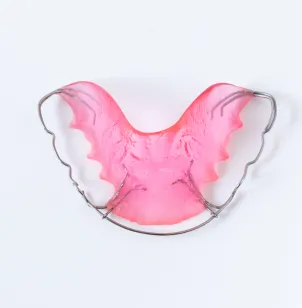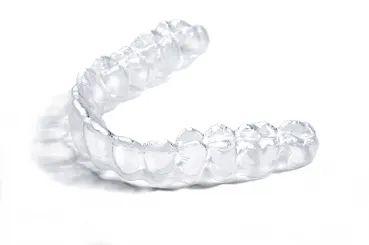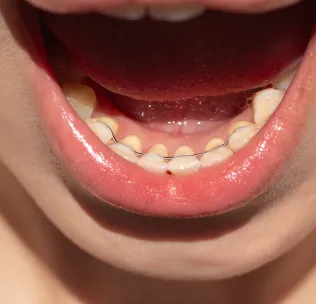Retainers are key to successful orthodontic maintenance. Teeth will naturally move as part of aging. To maintain orthodontic changes, retainers need to be worn indefinitely. There are three types of retainers we recommend.

Traditional retainer – Hawley Retainers
- The retainer is fabricated in a lab with a metal anterior bar and acrylic to cover the roof of the mouth and the lingual surface of the lower jaw. The benefit of this type of retainer is that it allows the chewing surfaces of the teeth to be in contact and allows natural movement of the teeth to settle. It can also last 10-15 years without any issues. The downside of this type of retainer is that the patient tends to lisp in the beginning due to the thickness of the acrylic, and it does not protect your teeth from grinding if you are a bruxer or clincher. If you are a clincher/bruxer, we recommend MAGO (Maxillary Anterior Guided Orthotics) for the upper and lower Hawley retainer.
Clear retainer
- Clear retainers have high esthetics and are an easy transition for patients who have had Invisalign treatment. If you forget to wear the retainer for a few weeks and notice your teeth have slightly moved, a clear retainer can be used tocorrect minor changes. It can also help patients who clench and grind their teeth by protecting them. However, the downside of the clear retainer is that it tends to discolor and break easily, especially if you are a clincher/bruxer.


Fixed retainer
- Fixed retainers are great alternatives for adult patients who do not have healthy bone and experience slight movement of the teeth. Fixed retainers are glued to the back of the teeth with bonding material to connect all front teeth together, strengthening against mobility. It is also a great option for young patients who are too busy and forget to wear traditional retainers. The downside of the fixed retainer is difficulty with flossing, oral hygiene, and the need to be careful using front teeth to incise hard food since bonding can break just like braces. Other issues may occur when it breaks; most patients are not aware of the broken retainer until they notice the teeth have moved.
Retainer Schedules
- We typically recommend 3-6 months of full-time wear for adults and 1 year of full-time wear for minors. After such times, the patient can change to nighttime wear only.
- We have different retainer check schedules. We see the patient for 1 month, 3 months, 6 months and every year after that indefinitely. We believe in lifelong retainer maintenance. Your teeth will move regardless of whether you had braces or not, third molars extracted or not if retainers are not worn. It is part of the aging process.
Contact us today at (402) 614-7022 to learn more about retainer fabrication in La Vista, Nebraska, and the surrounding areas, including Elkhorn, Omaha and Papillion, Nebraska, and schedule your appointment with Dr. Kim.




 402-614-7022
402-614-7022